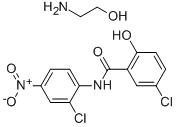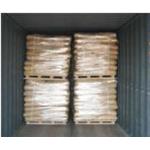Chemical Properties
Depending on purity, a bright yellow or brownish-yellow crystalline solid or powder. Odorless. Soluble in water
Uses
The ethanolamine salt as a molluscicide.
General Description
Yellow solid. Insoluble in water.
Air & Water Reactions
Insoluble in water.
Reactivity Profile
Niclosamide ethanolamine salt is hydrolyzed by concentrated acid or alkali.
Fire Hazard
Flash point data for Niclosamide ethanolamine salt are not available. Niclosamide ethanolamine salt is probably combustible.
Agricultural Uses
Molluscicide: Niclosamide, the parent chemical, is a relatively
selective, non-cumulative chlorinated aromatic amide pesticide. Clonitralid (ethanolamine salt of Niclosamide) is
used principally against molluscs, especially fresh water
snails and to control sea lamprey larvae and also as an antiparasitic drug in human, pets and livestock. Niclosamide is
toxic to all fish species at 0.5 mg/L (48 hours). A U.S. EPA
restricted Use Pesticide as Niclosamide. Limited to use by
a certified applicator [40 CFR 152.175 (a) (7/1/94)]. Not
listed for use in EU countries. Registered for use in
the U.S.
Trade name
BAY 73® and U.S. Fish and Wildlife
Service; BAY 6076®; BAYER 73®; BAYER 25648®;
BAYLUSCID®[C]; BAYLUSCIDE® and U.S. Fish and
Wildlife Service; M 73®; MOLLUSCICIDE BAYER
73®; NICLOSAMIDE®; SR 73®
Biological Activity
Cell permeable: yes
Potential Exposure
Niclosamide, the parent chemical, is a relatively selective, noncumulative chlorinated aromatic amide pesticide. Clonitralid (ethanolamine salt of niclosamide) is used principally against molluscs, especially fresh water snails and to control sea lamprey larvae and also as an antiparasitic drug in human, pets, and livestock. Niclosamide is toxic to all fish species at 0.5 mg/L (48 hours). A restricted use pesticide in the United States. Limited to use by a certified applicator . Not listed for use in EU countries.
Shipping
UN2588 Pesticides, solid, toxic, Hazard Class: 6.1; Labels: 6.1-Poisonous materials, Technical Name Required. UN2902 Pesticides, liquid, toxic, n.o.s., Hazard Class: 6.1; Labels: 6.1-Poisonous materials, Technical Name Required.
Incompatibilities
Incompatible with oxidizers (chlorates, nitrates, peroxides, permanganates, perchlorates, chlorine, bromine, fluorine, etc.); contact may cause fires or explosions. Keep away from alkaline materials, strong bases, strong acids, oxoacids, epoxides. Hydrolyzed by strong acids, and alkalies. Slowly hydrolyzes in water, releasing ammonia and forming acetate salts. Decomposes at B200-205°C.
Waste Disposal
Do not discharge into drains or sewers. Containers must be disposed of properly by following package label directions or by contacting your local or federal environmental control agency, or by contacting your regional EPA office. Burn in incinerator specifically designed for pesticide disposal or dispose as a hazardous waste in a landfill approved and licensed for the disposal of pesticides. Consult with environmental regulatory agencies for guidance on acceptable disposal practices. Ultimate disposal of the chemical must consider: the material’s impact on air quality; potential migration in soil or water; effects on animal, aquatic, and plant life; and conformance with environmental and public health regulations




